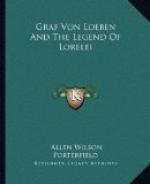[34] An instance of this is seen in Selections
from Heine’s
Poems, edited by H.S.
White, D.C. Heath & Co., Boston, 1900,
p. 182. Professor White
does, to be sure, refer to Strodtmann for
the details; but Strodtmann
does not prove anything. And in
Heines Werke in fUenfzehn
Teilen, edited by Hermann
Friedeman, Helene Herrmann.
Erwin Kaliseher. Raimund Pissin, and
Veit Valentin, we have the
comment by Helene Herrmann, who follows
Pissin: “Die Loreleysage,
erfunden von Clemens Brentano; vielfach
von Romantikern gestaltet.
Zwischen Brentanos Romanze und Heines
Situationsbild steht die Behandlung
durch den Grafen Loeben, einen
unbedeutenden romantischen
Dichter.”
[35] The best finished collection of Heine’s
letters is the one by
Hans Daffis, Berlin, 1907,
2 vols. This collection will, however,
soon be superseded by Heinrich
Heines Briefwechsel, edited
by Friedrich Hirth, MUenchen
and Berlin, 1914. The first volume
covers Heine’s life
up to 1831. In neither of these collections is
either Brentano or Loeben
mentioned. There are 643 pages in
Hirth’s first volume.
[36] For a discussion of Godwi, see Clemens
Brentano: Ein
Lebensbild, by Johannes
Baptista Diel and Wilhelm Kreiten,
Freiburg i.B., 1877, two volumes
in one, pp. 104-25. As to the
obscurity of Brentano’s
work, one sentence (p. 116) is
significant: “Godwi
spukt heutzutage nur mehr in den KOepfen
der liberalen Literaturgeschichtsschreiber,
denen er einen
willkommenen Vorwand an die
Hand gibt, mit einigen stereotyp
abgeschriebenen Phrasen den
Stab Ueber den phantastischen,
verschwommenen, unsittlichen
u.s.w., u.s.w. Dichter zu brechen.”
[37] Clemens Brentano: Godwi oder das steinerne
Bild der
Mutter. Ein verwilderter.
Roman. Herausgegeben und
eingeleitet von Dr. Anselm
Ruest, Berlin, 1906. Ruest edited the
work because he thought it
was worth reviving. In this edition,
the ballad is on pages 507-10.
Bartels (Handbuch, 2d ed., p. 400)
lists a reprint in 1905, E.A.
Regener, Berlin.
[38] II, 391-93.
[39] For the various references, see Thorn’s
Heinrich Heines
Beziehungen zu Clemens Brentano.
pp. 88-90. His study is
especially unsatisfactory
in view of the fact that he says (p. 88)
in this connection: “Wirklich
Neues zu bringen ist uns nicht
vergOennt, denn selbstverstAendlich
haben die Forscher dieses
dankbare und interessante
Objekt schon in der eingehendsten Weise
untersucht.” And
Thorn’s attempt to show that Heine knew
Godwi early in life
by pointing out similarities between
poems in it and poems by Heine
is about as untenable as argument
could be, in view of the great
number of poets who may have
influenced Heine in these
instances; Thorn himself lists (p. 63)
BUerger, Fouque, Arnim, E.T.A.
Hoffmann.




